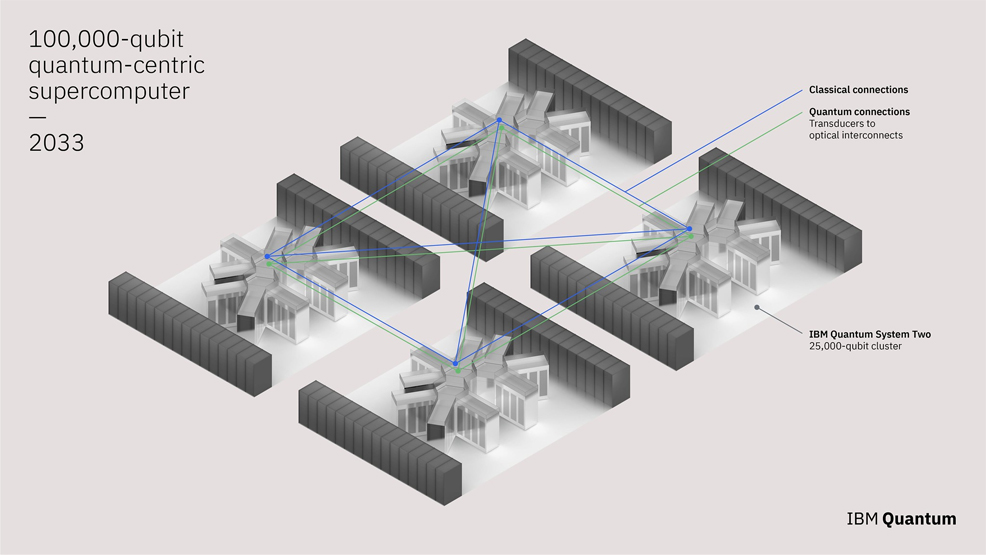
29th May 2023 IBM planning 100,000-qubit quantum computer for 2033 IBM has announced a 10-year, $100 million initiative with the University of Tokyo and the University of Chicago to develop a quantum-centric supercomputer powered by 100,000 qubits.
Quantum-centric supercomputing is an entirely new – and as of now, unrealised – era of high-performance computing. A 100,000-qubit system would serve as a foundation to address some of the world's most pressing problems that even the most advanced supercomputers of today may never be able to solve. Such a machine could, for example, unlock totally new understandings of chemical reactions and the dynamics of molecular processes. In turn, this could enable researchers to help study climate change through modelling better methods to capture carbon; discover materials to build next-generation batteries for EVs and energy grids; and uncover more effective and efficient fertilisers to boost food production. To usher in this major new paradigm, a global collaboration of talent and resources across industries and research institutions is being initiated. IBM will partner with the University of Chicago, the University of Tokyo, and IBM's broader ecosystem, to advance the underlying technologies, as well as to design and build the necessary components at scale. Moving forward, IBM intends to expand these partnerships to include Argonne National Laboratory and Fermilab National Accelerator Laboratory, both of which are members of the Chicago Quantum Exchange and home to two respective Department of Energy quantum hubs. Importantly, the two laboratories offer capabilities and expertise that can facilitate delivering the technologies envisaged in the race to build a quantum-centric supercomputer.
The design of this 100,000-qubit system will integrate classical and quantum computers. Its foundation will include milestones IBM has already outlined on its Quantum Development Roadmap, such as the ability to scale and connect rapidly growing numbers of processors through quantum interconnects, alongside new technology to mitigate errors from "noisy" quantum states. Last year, IBM unveiled 'Osprey', featuring 433 qubits, the highest number ever achieved for a quantum processor. The company is expected to demonstrate an even more powerful processor by the end of 2023. Known as 'Condor', it will be the first to exceed 1,000 qubits. Yet even these impressive numbers will be dwarfed by orders of magnitude compared to what is planned for 2033. "Over the past several years, IBM has been at the forefront of introducing quantum technology to the world," said Arvind Krishna, the Chairman and CEO of IBM. "We have achieved significant progress along our roadmap and mission to globally establish useful quantum technology, so much so that we can now, with our partners, truly begin to explore and develop a new class of supercomputing anchored by quantum." "Achieving breakthroughs at scale in quantum technology requires deeply rooted and productive collaboration around the world and across a broad range of industry, academic, and government partners," said Paul Alivisatos, President of the University of Chicago and a pioneer in the development of nanomaterials. "Quantum information science and technology is at a crossroad where foundational discovery and technical innovation will combine to create real breakthroughs. The University of Chicago is thrilled to partner in this endeavour." "We expect our partnership will lead to scientific breakthroughs, acceleration of the adoption of quantum computing for the coming era, and active engagement into the critical societal challenges of humanity. We also aim to contribute to the realisation of a better future society by nurturing diverse talents," said President of the University of Tokyo, Dr. Teruo Fujii.
Comments »
If you enjoyed this article, please consider sharing it:
|








